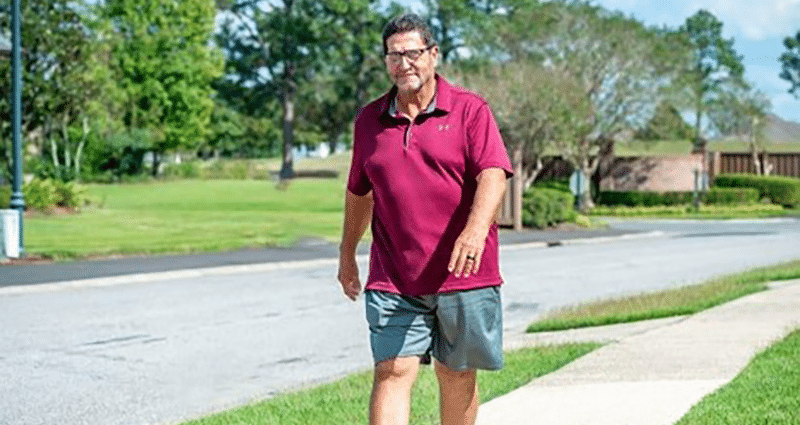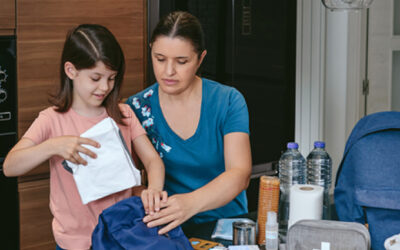In 2015, Patrick Dubois noticed an odd clicking sensation in his left knee during his evening stroll around the Chevron compound in Nigeria, where he worked. “It wasn’t tremendous pain,” he said. “It was just the first time I noticed that something was going wrong.”
The pain level continued to increase after he retired in 2016 and moved to Abbeville. By 2018, Dubois said, he was walking with a limp.
“It got to a point where if I had to climb a ladder, go up steps, walk an incline, even walking up a small hill, it was very painful,” said Dubois, whose physicians, at the time, treated the symptoms with injections and bracing. Still, the pain persisted.
Dubois was determined to keep doing what he wanted. He and his wife live in Broussard but own a rural getaway nearby, where he goes three times a week. While he kept up with his chores on the property, Dubois said the pain made the effort twice as hard and took twice as long to accomplish.
Dubois’ sister had undergone knee replacement with good results, so he made an appointment in late May with Dr. James B. Kyle, the orthopedic surgeon who had performed her surgery.
“I told him that it was like my motor was still running at full speed and I had a flat tire,” Dubois said. “I had so much energy, and yet my legs were holding me back from completing what I had to do. The minute he said, ‘Well, you’re bone-to-bone. Injections will not help you. We need to think about surgery in the future,’ I said, ‘I’m ready now.’”
Osteoarthritis of the knee can be caused by age, genetics, wear and tear, injury or inflammatory issues, Dr. Kyle explained. While it is more prevalent in older people, some could develop it at younger ages. There are two types of treatment, he continued, non-operative and operative.
“We always do the non-op stuff first — injections, anti-inflammatories, activity modification, weight loss, assisted devices, bracing and therapy — to keep you out of the operating room. If we’re successful, I call that a home run,” Dr. Kyle said. “If it’s not successful, the X-rays show severe arthritic changes, and the pain is intolerable, then we’ll talk about the next step. If that patient is healthy enough and has realistic expectations, then we’ll indicate them for a knee replacement.”
In bone-on-bone arthritis cases, like Dubois’, Dr. Kyle noted, the cartilage that normally cushions the end of the thigh bone (femur) and top of the shin bone (tibia) has totally worn away, resulting in pain, stiffness, swelling and other problems. At that point, surgery is recommended.
Dr. Kyle performed knee replacement surgery for Dubois on July 8 at Our Lady of Lourdes Regional Medical Center. He was assisted by the Zimmer Biomet ROSA® (Robotic Surgical Assistant) Knee System technology that allows for a more accurate and efficient procedure. Special X-rays taken before the surgery were sent to the engineers at Zimmer Biomet, who used measurements and calculations to create a template that was specific to Dubois, so Dr. Kyle had a good grasp of the type of deformity and size of implant needed before making the first incision.
With the assistance of the robot, tracker pins were placed in both the femur and tibia so the robot would know where the knee was at all times. The robot then gave Dr. Kyle an idea of what kind of gaps were within Dubois’ knee.
“That’s one of the real powers of robotic surgeries,” Dr. Kyle said. “I can freely move these parts in space, essentially on a model within the robot on a screen, to figure out where I want to put them. I can move the parts out and try different sizes and shapes and flexions of the different components all before ever making a cut.”
The entire procedure takes only about 90 minutes. The patient is on his feet the same day and goes home the next. Dubois said he experienced no pain while in the hospital. Once he got home, Dubois noted he was off pain medication in about three or four days.
Dubois completed physical therapy at the end of August and is exercising regularly at a gym. Accomplishing his chores is easier now, Dubois said, and he’s walking much better.
“We went on a trip last year and my wife, my brother-in-law and sister-in-law were 50 feet ahead of me. I was trying to just keep up with them,” he said. “In today’s world, even though it’s only been three months, I could keep up with them.”
About 80% of the pain is gone, Dubois said. Dr. Kyle told him it would take a year for complete healing, he noted, but Dubois is extremely happy about his current results and his experience with Dr. Kyle.
“I don’t want to say I love him,” Dubois said, but I do.”
Robotic knee replacement surgery with the Zimmer Biomet ROSA® (Robotic Surgical Assistant) Knee System technology at Our Lady of Lourdes allows for a more accurate and efficient procedure. The system collects data before and during surgery to inform the surgeon of unique details in a patient’s body that may affect the implant’s fit. Using this information, surgeons are able to provide a personalized surgery based on individual needs. Discover more at LourdesRMC.com.




